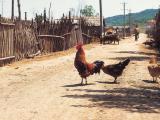Officials from the US Centers for Disease Control and Prevention (CDC) today said serologic testing has ruled out H5 avian flu infection among five healthcare workers who had symptoms around the time they were exposed to a patient in Missouri, though results suggest a household contact was likely infected at the same time.
At a Department of Health and Human Services briefing today, CDC officials also said tests have confirmed H5 infection in two Washington poultry cullers, though the virus is the D.1.1 genotype, which is different that the B3.13 genotype circulating in US dairy cattle.
Missouri household contact likely exposed to same source
Demetre Daskalakis, MD, MPH, who directs the CDC's National Center for Immunization and Respiratory Diseases, said the CDC faced challenges with serologic tests to assess if symptomatic health workers exposed to an earlier confirmed hospitalized patient in Missouri, along with a household contact of the patient, had also contracted the virus. For example, the patient’s sample didn’t yield all sequences of the virus, and CDC scientists had to reverse-engineer it to develop serologic tests.
Tests on blood samples of all five health workers were negative on all serologic tests, which rules out person-to-person spread in the hospital setting, Daskalakis said. The CDC today also detailed the findings in a Spotlight on its website. A sixth health worker had respiratory symptoms but tested negative for H5, so that patient didn’t undergo serologic testing.
Results from the suite of three serologic tests showed that the patient’s household contact, who came down with gastrointestinal symptoms on the same day as the patient, was likely exposed to the virus but doesn’t meet the criteria to be counted as human H5N1 case. The patient and the household contact both tested positive on a microneutralization assay but not the other two tests. In earlier testing, the patient’s respiratory sample was positive on polymerase chain reaction (PCR) testing.
Daskalakis said the identical illness onsets of the patient and the household contact hint at exposure to an unknown animal source or animal product rather than human-to-human spread.
Washington cases confirmed but don’t involve cattle genotype
Meanwhile, Nirav Shah, MD, JD, the CDC’s principal deputy director, said CDC tests have confirmed H5 in two of the four presumptive positives from Washington state poultry cullers. He added that further testing is under way on at least five other presumptive positives from the state.
The cases, Washington’s first, were announced by state health officials on October 20. The workers were part of a team culling poultry in the wake of a large outbreak on a layer farm in Franklin County. Shah said the two patients with confirmed infections had mild respiratory symptoms and conjunctivitis.
He said the genotype is D1.1 and belongs to the 2.3.4.4b clade that is circulating globally in wild birds, with occasional spillovers to poultry flocks. Though the D1.1 genotype is distinct from the B1.13 virus circulating in US dairy cattle, it causes similar mild symptoms, including conjunctivitis.
He credited Washington state for its strong public health preparedness and said its health officials have been conducting exercises to prepare for outbreaks in animals and the arrival of human cases. Nirav said health officials were in the midst of such an exercise in the region where the poultry outbreak occurred on the same day the first human cases were picked up. “Some thought it was an injection into the exercise,” he said.
For now, the national total of H5 infections this year is 31 cases, which Shah said is expected to rise as more confirmation tests are completed. Washington health officials had also said they expect the number of confirmed cases to rise, as state testing identifies more suspected cases.
Health officials said the risk to the general public remains low but is higher for people who have occupational exposure to sick animals.
More positive herds in California and Idaho; Utah launches bulk milk-tank testing
The US Department of Agriculture (USDA) Animal and Plant Health Inspection Service (APHIS) confirmed three more outbreaks in California dairy herds, raising its total to 137, and two more in Idaho, pushing the state’s total to 36. So far, tests have confirmed avian flu in 339 dairy herds across 14 states.
Meanwhile, the Utah Department of Agriculture and Food (UDAF) yesterday announced mandatory weekly bulk tank sampling for all dairy herds in Cache County, following the confirmation of a large outbreak at a layer farm in Cache County that has more than 1.8 million birds.
“Genetic sequencing has confirmed that the HPAI H5N1 virus recently detected in a Cache County commercial poultry facility is the same one that has impacted dairy cattle in other states,” the UDAF said. “Currently, there have been no confirmed cases of HPAI [highly pathogenic avian influenza] in Utah dairies.”
A positive bulk milk-tank sample would trigger quarantine of the dairy herd and movement restrictions on lactating cows, except for those going directly to slaughter, the UDAF said.



















